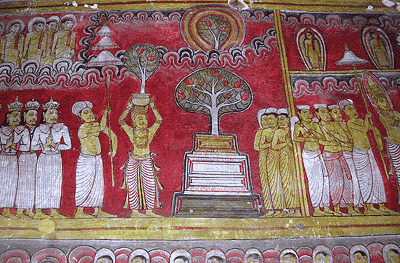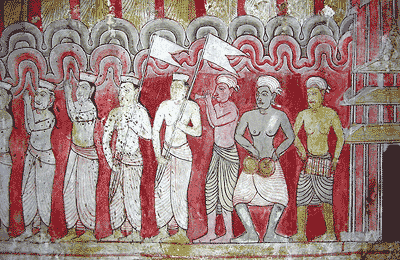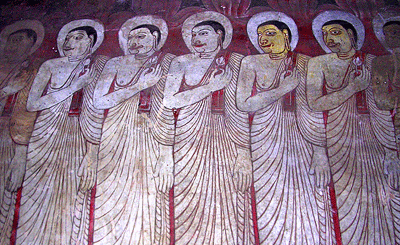SACRED ISLAND
A BUDDHIST PILGRIM'S GUIDE TO SRI LANKA
compiled and edited by Ven. S. Dhammika
HINT'S FOR PILGRIMS
What follows are some hints about traveling in Sri Lanka that will help make your pilgrimage more fruitful.
What To Bring
Sri Lanka is generally hot and humid except in the mountains which are usually pleasantly cool. Several pairs of light clothes are all you will need during most of your stay. If you intend to spend time in a meditation centre or perhaps stay in a hermitage at least two pairs of white clothes, tee shirts and trousers or sarongs, will be necessary. A good pair of walking shoes or strong sandals will also be essential because places like the sacred cities require a lot of walking. But be careful – Sri Lankan temples usually don’t have a shoe minder and good footwear left at temple entrances has a tendency to disappear. Bring either a wide brimmed hat or an umbrella to protect you from the heat and perhaps some sunscreen. Another thing that can protect you from the heat is to drink plenty of fluids. If you have your own water bottle with a shoulder strap you can drink whenever you need to and wont have to keep buying bottled water and thus contributing to plastic bottle pollution.
Some reading material might be useful on your pilgrimage. The ubiquitous Lonely Planet guidebook to Sri Lanka will give you up-to-date information on visas, accommodation, prices, etc. And the Lonely Planet’s Sri Lanka Phrase book might be useful also although English is widely spoken throughout the country. Sacred Island – A Buddhist Pilgrim’s Guide to Sri Lanka, is also essential reading. This book covers all the places mentioned here and more and in much greater detail. Many of the legends associated with each place are included too. Sacred Island will be available from the Buddhist Publication Society, PO Box 61, Kandy, Sri Lanka. (picture of book here when it becomes available).
A map to Sri Lanka will be essential and the Survey Department’s Road Map of Sri Lanka published by the Survey Department is as good as any. You can get it from the Survey’s sales outlet at 62 Chatham Street, Fort, Colombo. Other maps and books on Sri Lanka can be purchased in most of Colombo’s several bookshops. The two most comprehensive of these are Vijitha Yapa Bookshop, Unity Plaza, Galle Road, Bambalapitiya, and Lake House Bookshop, Liberty Plaza, R.A. de Mel Mawatha, Kollupitiya.
When To Go
There are only two seasons in Sri Lanka, the wet and the dry and roughly two climate zones, the lowlands and the mountains. The temperature is most comfortable in the lowlands between June and December although it rains a lot between October and November. The hill country is pleasantly all year around but it rains a lot between May and August and October and November.
The Cultural Triangle
Throughout the 1990’s the Sri Lankan Government together with UNESCO carried out extensive excavations at many of the country’s archeological sites, restored previously sites excavated and built or upgraded several museums. To help finance this work tickets are now required to enter nearly all the archeological sites in the country. The system ticketing system is unfortunately geared entirely to the needs of package tourism rather than the individual tourist or traveler. For the average tourist who just wants to be driven through the ruins taking a few photos one day each in Anuradhapura and Polonnaruwa is more than enough. But for the pilgrim or art lover, who would like to stroll through the ruins stopping from time to time for meditation or to feel the atmosphere it is not nearly enough. So unless you are prepared to rush through everything there is no alternative to buying two or more tickets. Note also that your ticket is supposed to cover entrance into Dambulla, Avukana and all the sites at Anuradhapura when in fact it does not. You will have to pay extra to visit Dambulla, Isaramuni at Anuradhapura, Avukana and Mahintale.
Food
Sri Lanka has its own unique cuisine although those not used to it often find it very oily and overly salted. Another problem some visitors have with the food is that it can be very hot, sometimes hot enough to take the mucus membrane off your mouth as it goes in and the lining off your bowels as it comes out the next morning. Most meditation centers don’t make provisions for foreigners as far as the chili in food is concerned or if they do it doesn’t seen to make much difference. Two thing you can do to minimize this problem is to drink coconut milk with your meal or mix a bit of curd in it. This can really take the fire out of a hot dish. Vegetarianism is common in Sri Lanka and many places offer meat free dishes. Most people staying in meditation centres observe the eight or ten Precepts one of which is to abstain from eating after noon. Consequently meditation centres do not usually provide supper although tea is always available. Outsides the cities soft drinks are available but they are not always refrigerated. Anyway, a far better alternative to soft drinks or bottled water is coconut milk which can be very refreshing even when not cold. The bright orange coconuts are called tambili while the larger green ones are called karumba. Both are widely available everywhere.
Festivals and Holidays
Sri Lanka has about 30 public holidays every year, more than any other country. It can be very inconvenient to be in need of something only to find that all shops, banks and government offices are closed for the day. The Tourist Board publishes an annual Calendar of Events which will inform you of coming holidays. The main Buddhist holidays and festivals are these.
Duruthu Perahera. Held on the full moon of January this is a smaller but nonetheless coluorful and vibrant version of the Kandy Perahera.
Vesak
According to the Theravadin tradition the Buddha was born, enlightened and attained final Nirvana on the full moon of the third Indian month Vesak (Pali, Vesakha). It seems that Vesak has been celebrated from the time Buddhism was introduced to the island although the first actual mention of it is from the reign of Dutthagamani in the 1st century BCE. This festival is celebrated in Sri Lanka with enormous enthusiasm. For a week or so before, boys and youths are busy making geometrically shaped lanterns out of semi-transparent paper usually of soft pastel colors and often with long graceful tails. Nearly every house in the country will have at least one of these lanterns, some quite modest, others large, elaborate and of great beauty. Many people will spend Vesak evening going around looking at the lanterns and particularly beautiful ones will attract large appreciative crowds. Ambalamgoda on the coast south of Colombo is particularly famous for the size and creativity of its lanterns. Throughout the year all the families or businesses in one street will collect money and on Vesak eve build a stall at the end of their street and offer food and drink to all comers.

Worship of the bodhi tree - a painting from Damulla
Again neighborhood committees or wealthy people will pay for the construction of what are called pandels, large boards with illustrations of the life of the Buddha or various Jataka stories. These pandles are illuminated with hundreds of colored light bulbs and sometimes have moving panels allowing particular stories to unfolded gradually. In the cities pandles are usually put up at main intersections and attract huge crowds. In Sri Lanka, Vesak has not yet been spoiled by commercial considerations and the generosity, good will and piety that one encounters everywhere can be very moving. Both Vesak and the day following are public holidays.
Poson
This festival commemorates the arrival of Mahinda in Sri Lanka and is held on the full moon after Vesak. The first mention of this festival is during the reign of King Srimeghavanna. He is said to have had the whole of Anuradhapura beautifully decorated and then a golden statue of Mahinda taken in procession from the city to Mihintale. Today there are special events and sermons throughout the country and monasteries are filled with people observing the eight or ten Precepts. Thousands of pilgrims converge on Mihintale and spend the whole night on the mountain meditating, chanting or doing pujas. All Mihintale’s stupas are illuminated with thousands of lights, everyone has their own little oil lamp and the whole places becomes literally a mountain of light.
The Esala Perahera
This event is held on the full moon of July or August depending on the year and goes for ten days. The Perahera as is it is today dates from the times of Kandyan kings although taking the Tooth in public procession goes back more than a thousand five hundred years. Fa Hsien has left us a vivid description of the ancient forerunner of the present Perahera as it was done during the 5th century in Anuradhapura. The city was cleaned and beautified and paintings of all the 552 Jataka stories were put up along all the roads. The Tooth was taken out of its temple and carried in a colorful procession northwards along main road to the a special temple in the Abhayagiri Monastery where huge crowds gathered to worship it.

Medieval depiction of a religious procession
The modern Perahera is led by several dwarfs cracking huge whips to clear the crowds. Next come contingents of drummers vigorously beating a variety of drums and then the beautifully decorated elephant carrying the Tooth casket on its back. A pure white cloth is laid before the elephant to walk and a exquisitely embodied canopy is held above it. In actual fact the Tooth never leaves the Temple, only a replica is carried in the Perahera, although people treat it is if it were the original, standing up and worshiping it as it passes. The honor of carrying the Tooth is given to the biggest elephant in the country. After this come in succession drummers, dancers, acrobats and more elephants. The whole procession is accompanied on either side by lines of hundreds of men carrying flaming torches to provide illumination. Each night more performers and elephants are added so that on the last night the procession becomes one of the most spectacular sights to be seen anywhere. It can be a good idea, if the pilgrim has the opportunity, to join the crowds watching the Perahera one night and then the next night take Rajapihilla Mawatha up the hill on the other side of the lake and watch it from there. The light from the burning torches and the illuminated Temple reflected in the lake is quite a sight.
The Sri Pada Pilgrimage
One of the major events in Sri Lanka’s religious calendar is the annual pilgrimage to Adam’s Peak more correctly known as Sri Pada. The pilgrim’s season starts on the full moon of December when an 800-year-old white sandalwood statue of Samantha is carried up the mountain and enshrined there. The season officially finishes on the full moon of April (Vesak) when the statue is carried back down the mountain. It can be well worthwhile being in the country during this time in order to join the nearly quarter of a million others making the assent. More details will be given in the section on Sri Pada.
Other Holidays
All full moon days (Poya) are public holidays as are National Day (4th February) Christmas, Good Friday and New Years Day, May Day, Sinhala and Tamil New Year and the proceeding day (13 and 14 April) and the Hindu festival of Deepavali which is celebrated in either late October or early November.
Etiquette
In Sri Lanka the Buddhist values of gentleness, politeness and restraint are highly regarded and the etiquette of the culture is built around these values. While Sri Lankans are not as finicky about etiquette as the Thais or Burmese for example and would be far too polite to say anything when it is transgressed, like people everywhere they appreciate it when visitors to their country honor their customs. Here are a few hints on how to behave. When entering a temple or monastery it is polite to remove your shoes, take off your hat and lower your umbrella. Even some long ruined temples are considered sacred and should be treated as if they were still in use. Clothing that leaves the legs and shoulders exposed are not appropriate in temples. When preparing flowers to offer at a shrine it is considered bad manners to smell them and a flame used to light incense or an offering lamp should extinguished with a flick of the hand rather than blown out. When meeting a layperson it is usual to put ones hands together in the anjali gesture and say ‘Ayubowan’ meaning‘ Long life’. When meeting a monk people usually just bow although it is not necessary to do a full prostration as the Sinhalese do but to put your hands together in the anjali gesture and give a slight bow would be good. When given something or helped in some way you can say ‘Bhoma Stuti’ meaning ‘Much Thanks’.

Medieval depiction of a religious procession
Woman should never touch a monk and it is considered decorous for them not to stand too close to one either. As in most Asian cultures it is considered polite to eat, receive gifts and give them with the right hand as the left hand is used for washing after going to the toilet. Outside main tourist areas Sinhalese are very curious about foreigners and you will often be asked which country you come from and similar questions. Some visitors find this continual asking of the same questions a bit trying after a while. But be patient and remember that your questioner has probably never had the opportunities you have had to broaden their horizons. Reverse roles by asking your questioner about his or her life. This can make the conversation more interesting and can be a good way to get to know the people and the country better.
Meditation Centres
There are many meditation monasteries in Sri Lanka but only a small number of them are geared to provide for foreigners and few of the teachers in them are proficient in English. There are however several meditation centres which do cater for foreigners. Some meditation centres make a charge for food and accommodation, others don’t. Either way it is very bad karma to use a meditation center, monastery or hermitage as cheap or free accommodation. If you plan to stay for a while most centres are happy to provide you with a letter to the immigration authorities which usually helps in getting a visa extension. Again it is bad karma to get such an extension and then head for the beach.
Kanduboda Meditation Centre
Kanduboda at Delgoda out of Colombo has been welcoming Westerners for many years. The centre has accommodation for 75 people and a separate section for Westerners and for women. The present abbot Venerable Upali speaks English and is happy to give individual instruction to beginners. The regime is a strict one and will be of most benefit for those already experiences in meditation. Kanduboda teaches the Mahasi Sayadaw technique stressing mindfulness from moment to moment. To learn more about this approach to meditation read Mahasi Sayadaw’s famous book The Progress of Insight which is available from the Buddhist Publication Society in Kandy. For more information ring 2402306. To get to Kandauboda take the Pugoda Bus No 224 from the Pettha Bus Stand.
Sumathipala Meditation Centre
Just around the corner from Kanduboda is the new Sumithipala Meditation Centre. The abbot, Venerable Premasisi is a gentle patient monk with much experience teaching Westerners. There is accommodation for 70 people and the abbot gives instruction on an individual basis. For more information ring 2402805.
The Nilambe Meditation Centre
This meditation centre is perched on the top of a mountain with a magnificent view over the surrounding countryside. During 1980’s and 90’s the center became very popular with westerners because of Godwin Samararatna, an exceptionally kind and insightful teacher. Nilambe offers regular meditation courses and makes provisions for those wanting to do their own retreat. The centre also has a good library. For details of courses and how to get there visit the Buddhist Publication Society in Kandy or write well before hand to Nilambe Meditation Centre, Nilambe Bungalow Junction, Nilambe.
Dhammakuta Vipassana Meditation Centre
This centre offers 10-day courses using the technique taught by the Indian teacher S. N. Goenka. Courses are held every month but it is necessary to book beforehand. To get to Dhammakuta take the Mahakanda bus from Kandy and get off at the last stop. From there signs show the way up the hill to the center. If you are interested in Goenka’s particular approach to meditation it is good to read William Hart’s The Art of Living- Vipassana as Taught by S.N.Goenka before doing a course.
Lewella Meditation Centre
This is a small but friendly centre just out of Kandy and is meant for individual retreats. It has accommodation for six people and is at 160 Dharmasoka Mawatha, Lewella, Kandy.
© 2007 Copyright Ven. S. Dhammika & BuddhaNet/Buddha Dharma Education Association Inc.

